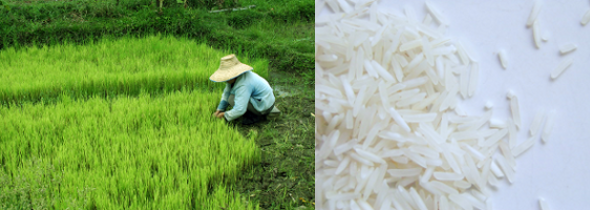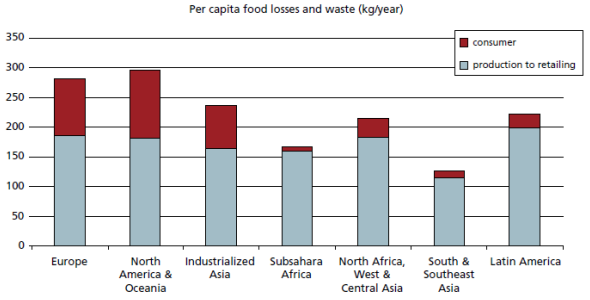Food Waste
Did you know that one-third of the food produced for consumption is wasted?
According to the Global Food Losses and Food Waste report published in 2011 by the Food and Agriculture Organization (FAO) of the United Nations, about 1.3 billion tonnes or one third of the food produced in the world for human consumption every year is lost or wasted throughout the supply chain, from production to consumption.
Impacts of Food Waste
Food that is wasted has several environmental, financial and social impacts. Food waste leads to a waste of resources used in food production and distribution, including land, water, energy, fertilisers, pesticides, labour and capital.
According to Tristram Stuart, the author of Waste, “the irrigation water used globally to grow food that is wasted would be enough for the domestic needs (at 200 litres per person per day) of 9 billion people” and “10% of rich countries’ greenhouse gas emissions come from growing food that is never eaten.”
Food waste disposal in landfills also produces methane, which is 23 times more potent than carbon dioxide as a greenhouse gas and contributes to climate change.
Here’s some figures and impacts of food waste in various countries:
In Hong Kong, over 3,000 tonnes of food waste is produced every day. In a single year, the volume can soar to over 1 million tonnes, which is equivalent to the weight of 70,000 double decker buses. … According to a study, Hong Kong people spend 350 billion HKD on dining out each year. However, 40% of the food ordered is left uneaten. On this basis, among the 150 HKD spent on lunch, 45 HKD is simply wasted away. In total, the whole HK population squanders 130 billion HKD on wasted food. Putting this in perspective, the amount wasted is enough to feed 2.8 million children in a poor country for a week.
In the United States 30% of all food, worth US$48.3 billion (€32.5 billion), is thrown away each year. It is estimated that about half of the water used to produce this food also goes to waste, since agriculture is the largest human use of water. Losses at the farm level are probably about 15–35%, depending on the industry. The retail sector has comparatively high rates of loss of about 26%, while supermarkets, surprisingly, only lose about 1%. Overall, losses amount to around US$90 billion–US$100 billion a year…
United Kingdom households waste an estimated 6.7 million tonnes of food every year, around one third of the 21.7 million tonnes purchased. This means that approximately 32% of all food purchased per year is not eaten. Most of this (5.9 million tonnes or 88%) is currently collected by local authorities. Most of the food waste (4.1 million tonnes or 61%) is avoidable and could have been eaten had it been better managed…
In a survey of more than 1,600 households in Australia in 2004 on behalf of the Australia Institute, it was concluded that on a country-wide basis, $10.5 billion was spent on items that were never used or thrown away. This amounts to more that $5,000/capita/year.
According to The Environmental Food Crisis report by UNEP, a “50% increase in food production by 2050” is needed to sustain the food demand from a growing world population, and the “world price of food is estimated to become 30–50% higher in coming decades and have greater volatility.” Preventing food waste helps to increase food availability and strengthen food security in such times.
More importantly, the food wasted could be used to feed the poor and the nearly one billion malnourished people in the world. Food that is edible should be channeled to the needy, and not wasted. According to Tristram Stuart, “all the world’s nearly one billion hungry people could be lifted out of malnourishment on less than a quarter of the food that is wasted in the US, UK and Europe.”
Food Waste along the Food Chain
Food waste occurs during the following stages in the food chain:
Agricultural Production: Waste due to damage and spillage during harvest operation; crops sorted out; animal death in the farm; fish discards; etc.
Postharvest Handling and Storage: Waste due to spillage and degradation during handling, storage and transportation; animal death during transport; degradation during fish storage and transportation; etc.
Processing: Waste due to sorting, trimming, spillage and degradation during industrial or domestic processing.
Distribution: Waste in wholesale markets, supermarkets, retailers and wet markets.
Consumption: Waste during consumption at the retail and household level.
Causes of Food Waste
The figure below shows the estimated food waste per capita in the various regions. For industrialized countries, more food is wasted as compared to the developing countries. In addition, less food is wasted at the consumer level for developing countries.
The causes of food waste in industrialized countries is mainly due to:
… consumer behaviour as well as to a lack of coordination between different actors in the supply chain. Farmer-buyer sales agreements may contribute to quantities of farm crops being wasted. Food can be wasted due to quality standards, which reject food items not perfect in shape or appearance. At the consumer level, insufficient purchase planning and expiring ‘best-before-dates’ also cause large amounts of waste, in combination with the careless attitude of those consumers who can afford to waste food.
The causes of food waste in developing countries are mainly due to:
… financial, managerial and technical limitations in harvesting techniques, storage and cooling facilities in difficult climatic conditions, infrastructure, packaging and marketing systems. Given that many smallholder farmers in developing countries live on the margins of food insecurity, a reduction in food losses could have an immediate and significant impact on their livelihoods.
Find out more about food waste from this TED talk by Tristram Stuart:
Images credit: Leftovers by Koh Sze Kiat; Rice by dmy; Seeds by lazysheep1; Per capita food losses and waste, Global Food Losses and Food Waste by FAO
Source credit: Global Food Losses and Food Waste by FAO; Tristram Stuart; Friends of the Earth (HK); The Environmental Food Crisis by UNEP












It’s really unbelievable how big amount of food is throwing away and how many people are starving in the same time…
I really liked this article. There is tone of waste. I find the one that really bothers me is the fast food coffee shops. After a certain time of day any muffins, cookies, bagels etc left on the shelf are put in the garbage. I don’t see why they couldn’t have been bagged and given to the locate Food Bank or shelter to feed people. Instead they went to the garbage dump. This should be looked into for all of these places that maybe some organization could pick up these items for feeding hungry people.
Great Article!!!!
Find your article useful and valuable. As we also manufacture organic waste to water machines. Our automated machine transforms your organic wet waste into water in 20 hrs.